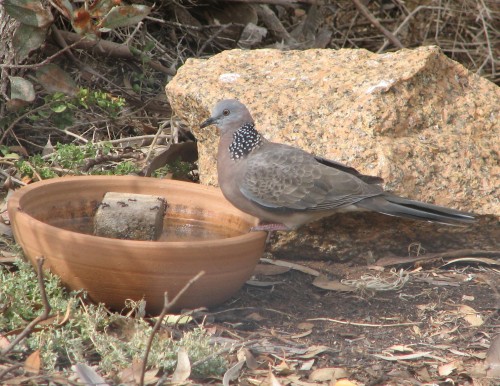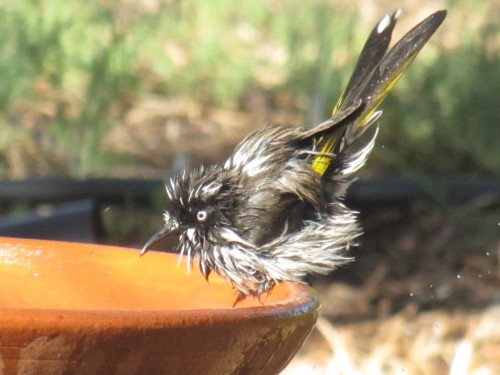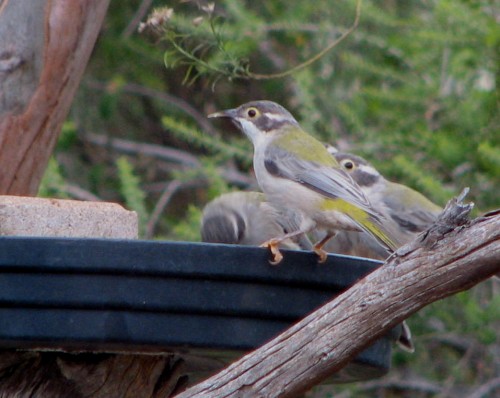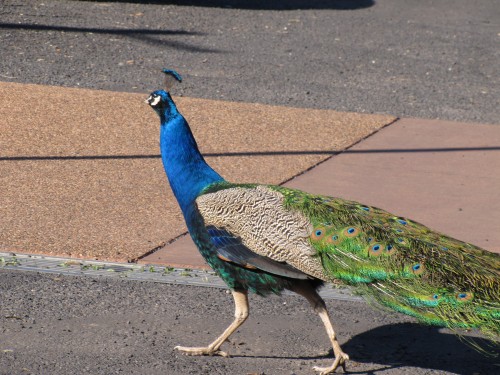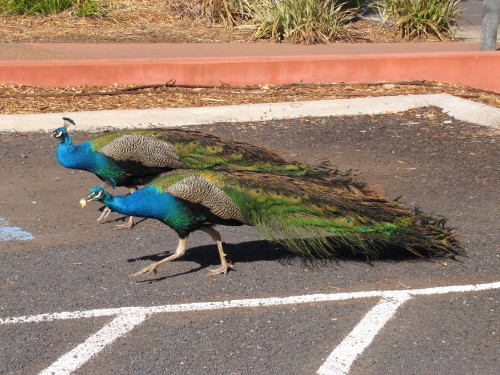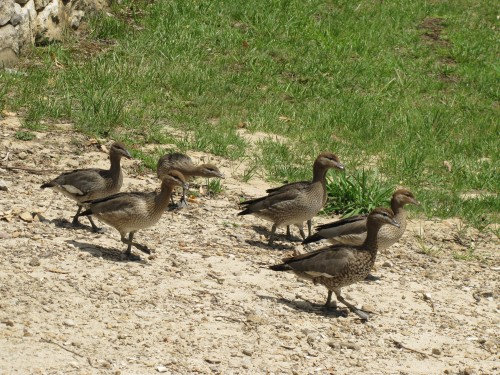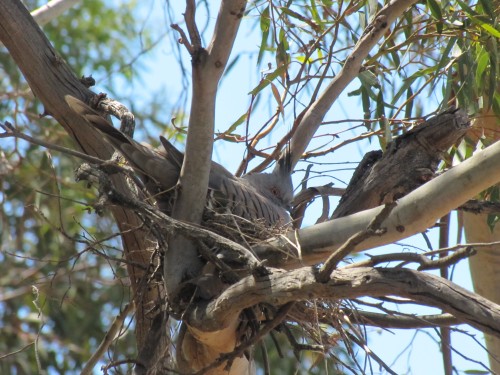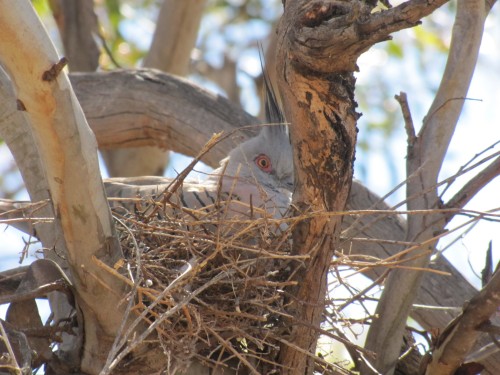The importance of water to birds
I love getting comments from my readers. Every now and then I get a really interesting one, like the one from Sue which I have quoted below.
Happy new year Trevor!
A Big thank you for maintaining your site…
I’m in suburban Adelaide, and I put a second bath into the garden when the hot weather struck early in the season. We have always had a terracotta pot pond with water lilies that allows for the bees to drink as well having a strong enough rim for some of the larger birds. The other two are just very large terracotta pot saucers, one on the ground, the other now in a raised garden bed under a deep shade tree.The ring neck dove (Spotted Turtle-dove) nested and fledged a chick in a hanging pot under the verandah.. Much cooler than her previous nest . Blackbird got it wrong and build a nest behind the fence post on the support rail .. But the iron faces west and is only shaded part of the day. She sat the nest for a full week before abandoning it, I suspect it was far too hot once the sun tracked round. Unfortunately, mid year, the neighbours had removed the large shrubs many of them had been using.
The New Holland honeyeaters, the Blackbird and the Wattlebirds have all now learnt to associate me out watering with a wet foliage cool off. The honeyeaters will actually make a fuss until I wet the bamboo down to make a cool and safe retreat then happily make use of it regardless of how close I am.
I suspect they may nest in the bamboo next year as its big enough to be a stable thicket.
All of them love it when the old fashioned rain wave sprinkler is put on.
They all seem to be learning new tricks to cope with the extra heat … with a little help from their friends.
Cheers
Sue.
Thank you, Sue, for sharing your delight in the birds in your garden.
If any of my readers would like to also share their experiences with birds in gardens – or other places for that matter, please leave a comment here on this article, or any article for that matter. You never know – I may feature your experiences in an article so everyone can read it.
Below I have included a few photos of birds at our bird baths.
Good birding,
Trevor.
Further reading:
- Time for a bath – an article about birds and other animals which have visited our bird baths.
Peacocks at Dubbo
Over recent posts here I have featured some of the birds I saw on a visit to the Western Plains Zoo near Dubbo, New South Wales. As we were leaving several peacocks strutted past us in the car park – all for the world like they owned the place. I have found that this is a common trait in this species of bird.
I should give this bird it proper name: Indian Peafowl. Most people I know will call it a ‘peacock’, but that is more correctly the name given only to the male. The female is called a peahen. The birds shown in today’s post are all males.
This most colourful and charismatic of birds is an introduced species in Australia. The species is native to India and Sri Lanka. Small feral populations exist in many parts of the world, Australia being no exception. They are a common adornment in zoos, parks and gardens in many parts of Australia.
Further reading:
Duck, duck, duck
Last week I had a medical procedure in a hospital in North Adelaide. The procedure – an endoscopy and a colonoscopy – went well and nothing nasty was found, though the lead up to it was challenging. Being on a fast for 25 hours was testing, as was the mixture one has to take to purge one’s alimentary canal, but I survived to tell the tale.
On my way to the hospital we had to pass Elder Park on the banks of the Torrens River immediately to the north of the CBD. This wide expanse of lawned area was being occupied by hundreds of Australian Wood Ducks, all grazing on the grass. I was driving so I was not able to get an accurate estimate of the numbers, but it seemed to be at least 200 or more.
And I didn’t have my camera either, so here is a photo of a family of Australian Wood Ducks taken at the Mt Annan Botanic Gardens in Sydney.
Crested Pigeons nesting in our garden
On our return from a recent holiday in Sydney we were having lunch on the back veranda. I was watching a Crested Pigeon fussing about in a tree about twenty metres away. Next thing it settled down as if on a nest. I left my food – actually I think I was at the cuppa stage of the meal – and moved slowly and carefully towards the nest. I’d remembered to go inside to get my camera first.
Sure enough – the pigeon was sitting on a nest. Crested Pigeons are very common around Murray Bridge. At times I have counted up to 50 sitting perched on power lines, often in a row. It’s quite a spectacular sight, though it is not common to see so many at one location. Loose groups of 5 to 15 are quite common, however.
Crested Pigeons are what I call a resident breeding species, meaning, they are resident all the year and that they breed in our garden. The nest shown in today’s photos is quite a substantial nest for a pigeon. Most pigeons and doves are not fastidious or elaborate when it comes to nest building. They seem to think that a dozen or so flimsy sticks placed at random in the fork of any tree or bush will do as a home for their chicks. How the eggs don’t fall through some nests I’ve seen is amazing. Still, they seem to manage; there are a lot of them around!
My writing of this post was interrupted by the load of washing finishing, and I am the one in our household who usually does the washing. The pigeon’s nest is near the clothes line and the bird is sitting tight, even when we walk within a few metres of the nest. She must have eggs, I think. I will keep a watch on proceedings.
UPDATE: January 22nd: over the last week we have had a heatwave with five days over 42C with several over 45C (113F). This was followed by several days of wild wind which broke several branches off our trees. The nest is still there but appears to have been abandoned.
Birds at Adelaide Writers’ Week 2010
Last week I attended the 2010 Adelaide Writers’ Week. This popular event is an important feature of the Festival of Arts held here every two years. Writers and readers come from all over Australia and attendees are treated to a large contingent of guest speakers, some Australian but many from overseas, with a sprinkling of local talent. Writers for children are conspicuous by their absence.
This event is spread over six days and is held in the Pioneer Women’s Memorial Gardens in the beautiful park-lands of Adelaide, just an easy five minute stroll from the CBD. All sessions are free – except for several evening sessions in the Town Hall. Panel discussions, book launches and meet-the-author sessions are run concurrently in two large marquees set up on the lawn, while a third is the book tent where you can buy the books of guest speakers and get them signed. There is also a catering tent for food and drinks.
While attending three days of this year’s Writers’ Week I was able to position myself during most sessions where I was also able to see out of the tents and observe the passing bird life. Being set in the gardens, and very close to the River Torrens, I was able to get a nice little list of bird seen. Below is an annotated list.
Galah: small groups seen flying over head along the river.
Rainbow Lorikeets: fast flying flocks seen and heard over head and feeding in nearby trees.
Noisy Miner: several heard calling from nearby trees. Interestingly I only saw one bird.
Australian Pelican: two seen gliding low over the river where they presumably landed (the trees obscured my view).
Sulphur-crested Cockatoos: several small flocks of 4-8 flew noisily overhead.
Australian Magpie: two heard carolling in nearby trees and several feeding on nearby lawns.
Silver Gulls: one or two seen often flying over head or along the river.
Australian Wood Duck: flock of about a dozen feeding on the grass within a few metres of the tent, quite unperturbed by the large numbers of people.
Black Swan: One seen sitting on the grass near where I parked the car next to the river (I was lucky enough to get a park each day very close to the venue).
Welcome Swallows: About 5 seen flying over the river.
Crested Pigeon: one seen feeding on the grass near the tents.
Pacific Black Ducks: Two flew between the tents at just over head height, narrowly missing people as they mingled near the Book Tent.
Little Pied Cormorant: one seen flying over the river.
Further reading:
